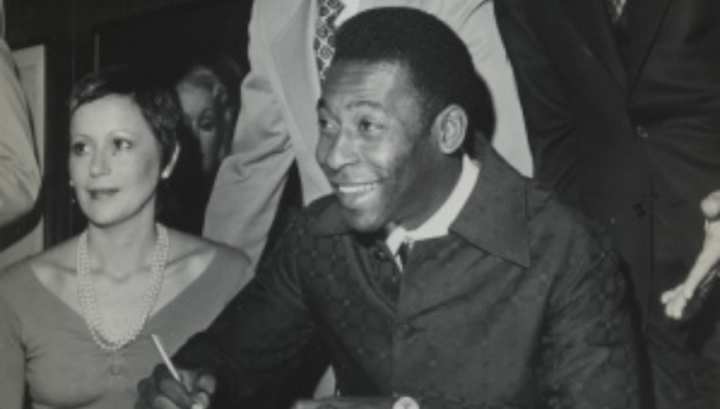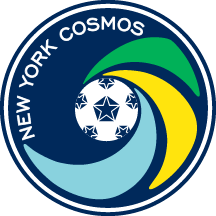News
Placing the Cornerstone

By Ben Lyttleton
Ed. note: This piece appeared in a commemorative magazine released immediately prior to the Cosmos' reboot match in fall 2013. We're placing it here in honor of Pelé's upcoming appearance at our 2015 Spring Season home opener - Saturday, April 18 at 7 p.m. ET.
It was December 1970. The team had no name, no stadium, no coach and no players. But in general manger Clive Toye, a former soccer writer for the English paper the Daily Express, the team that would become the New York Cosmos certainly had a man who knew the power of thinking big.
As far back as 1967, when he worked for the newly formed North American Soccer League and was charged with establishing a franchise in New York, Toye had earmarked the marquee player he wanted to play for that team – now his team. “He was the only guy in soccer that people outside the sport had heard of. He transcended the game,” Toye explains.
His name? Edson Arantes do Nascimento, world renown as Pelé.
For four long years, Toye traveled the world pursuing the Brazilian great, who had led his nation to three World Cup titles, earning the Best Young Player Award at age 17 in 1958 and standing as Brazil’s No. 2 goal scorer (tied for fourth overall in the tournament) in 1970. Toye and Pelé first met in January 1971, when Pelé’s side, Santos, played in Jamaica.
“I went to see him, and the first time I told him about [the NASL and professional soccer in New York], he thought it was nonsense,” Toye recalls with a chuckle. “But I found out wherever Santos or Brazil would be playing, and I followed him until he said, “No more of this!”
Toye faced tough competition for the world’s leading player. Both Juventus in Italy and Real Madrid in Spain wanted him, prompting Toye to counter: “If you go there, all you can win is a championship. If you come here, you can win a country.”
Toye even designed the Cosmos kit (uniform) to reflect Brazil’s yellow, green and blue colors. (He paid Atlanta artist Wayland Moore $250 to come up with the kit and logo.) When Pelé happened to be playing in the United States in another Santos friendly against Deportivo Cali of Colombia, Toye somehow got onto the pitch at halftime and presented him with a Cosmos No. 10 shirt.

Only once did Toye think the deal was dead, and at that moment, he switched his attention to George Best. The Manchester United winger had agreed to a deal, but when it came to signing, he was nowhere to be found. His teammate Pat Crerand accompanied Toye on a tour of drinking dens in Manchester, but Best had gone AWOL. (Eventually, Best would sign with the Los Angeles Aztecs.)
Toye thought he had clinched the Pelé signature in Brussels in summer 1975, after the Brazilian had played in a World Stars XI in Belgian star Paul van Himst’s testimonial match, Toye and Pelé were in a hotel room, about to sign the contract, when the door opened and in came (Portugal great) Eusebio, (Italy legend) Jose Altafini, and the rest of the team.
“Can I sign for Cosmos?” Altafini asked. Toye said yes, quoting a derisory salary which did not amuse the Italian. Toye had missed his chance to get Pelé to sign.
Two weeks later, this time in Rome, Toye tried again, adding a third year to the contract to allow Pelé to spent his final season playing in Giants Stadium, which would open in 1976.
“Clivey, my English is not so good,” said Pelé, who was negotiating along. “In Belgium, you say $3 million for two years, and now you say $3 million for three years!”
In the end, Toye got his man for even less: $2.8 million (and not the $4.5 million that many reported) for three years, and a 14-year worldwide marketing rights deal.
It didn’t take long for the Cosmos to recoup their investment. Toye did a deal with the NASL, ensuring the Cosmos were paid for the increase in attendances at away matches.
Two weeks after Pelé made his team debut, 35,260 fans watched the Cosmos play in Washington, almost 24,000 more than had ever witnessed a NASL game at RFK Stadium. Eight days later, 26,495 attended a friendly against the Whitecaps in Vancouver, B.C., 9,000 more than had ever gone to a Whitecaps home game. Even the NASL defending champion Aztecs drew 67 percent more than their season average when Pelé and the Cosmos came to town.
The club also went on tour, to Sweden, Norway (where the King of Norway was in attendance), Rome and the Caribbean. “We got huge crowds everywhere,” Toye says, “but even then I was always thinking of our strategy post-Pelé.”
Germany’s World Cup winner Franz Beckenbauer became Toye’s next top target, and he joined the club in 1977, in Pelé’s final season, playing alongside Italian forward Giorgio Chinaglia and Pelé’s international teammate Carlos Alberto. That was when the team’s popularity reached its peak. More than 77,000 fans watched the club’s playoff match against Fort Lauderdale, as the Cosmos went on to win the second of five NASL championships.
Pelé’s departure caused interest in the team – and the league – to wane. Eventually, Toye clashed with the club’s owners over the direction the team was taking: He wanted players raised through local youth systems alongside global superstars, while his bosses wanted only the superstars. “It was all about big names and Studio 54 for a while,” Toye says.
But that’s all in the past. Toye is excited about the Cosmos relaunch and has been impressed with new chairman Seamus O’Brien. “He doesn’t make big promises, and he has delivered so far,” Toye says. “It’s all very encouraging.”
Drawing a parallel between the Cosmos’ original launch and this rebirth, one can’t help but wonder which player Toye might have traveled the world pursing these past few years the way he did Pele in the 1970s. Lionel Messi? Cristiano Ronaldo? Not quite.
“It would be Ronaldinho,” Toye says. As Pelé’s natural heir as a Brazilian superstar, Ronaldinho is a fitting choice. “He’s fun. I’d pay to watch him. He would bring some electricity to the game, and he definitely still has the skills. I look at some other big-name players and don’t see any personality there at all.
“I want to see something special, something different and something memorable when I go to a game,” Toye adds. “I hope that’s what this Cosmos will bring to the fans.”



